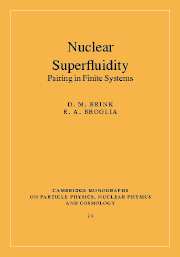Book contents
- Frontmatter
- Contents
- Preface
- 1 Introduction
- 2 The pairing force and seniority
- 3 The BCS theory
- 4 Spontaneous symmetry breaking
- 5 Pairing vibrations
- 6 Phase transitions
- 7 Plastic behaviour of nuclei and other finite systems
- 8 Sources of pairing in nuclei
- 9 Beyond mean field
- 10 Induced interaction
- 11 Pairing in exotic nuclei
- Appendix A A brief résumé of second quantization
- Appendix B Single particle in a non-local potential
- Appendix C Useful relations in the treatment of collective modes
- Appendix D Particle-vibration coupling
- Appendix E Model of the single-particle strength function
- Appendix F Simple model of Pauli principle corrections
- Appendix G Pairing mean-field solution
- Appendix H Pairing in a single j-shell
- Appendix I Fluctuations and symmetry restoration
- Appendix J RPA solution of the pairing Hamiltonian
- Appendix K Vortices in nuclei
- Appendix L Josephson effect
- References
- Index
1 - Introduction
Published online by Cambridge University Press: 17 August 2009
- Frontmatter
- Contents
- Preface
- 1 Introduction
- 2 The pairing force and seniority
- 3 The BCS theory
- 4 Spontaneous symmetry breaking
- 5 Pairing vibrations
- 6 Phase transitions
- 7 Plastic behaviour of nuclei and other finite systems
- 8 Sources of pairing in nuclei
- 9 Beyond mean field
- 10 Induced interaction
- 11 Pairing in exotic nuclei
- Appendix A A brief résumé of second quantization
- Appendix B Single particle in a non-local potential
- Appendix C Useful relations in the treatment of collective modes
- Appendix D Particle-vibration coupling
- Appendix E Model of the single-particle strength function
- Appendix F Simple model of Pauli principle corrections
- Appendix G Pairing mean-field solution
- Appendix H Pairing in a single j-shell
- Appendix I Fluctuations and symmetry restoration
- Appendix J RPA solution of the pairing Hamiltonian
- Appendix K Vortices in nuclei
- Appendix L Josephson effect
- References
- Index
Summary
Pairing in nuclei, superconductors, liquid 3He and neutrons stars
If one sweeps a magnetic field through a metallic ring (e.g. a ring made out of lead) immersed in liquid helium (T ∼ 4 K) it induces a current which does not show any measurable decrease for a year, and a lower bound of 105 years for its characteristic decay time has been established using nuclear resonance to detect any slight decrease in the field produced by the circulating current (File and Mills (1963)). If a torus-shaped vessel filled with liquid helium below the critical temperature Tc = 2.17 K (known as He II) and packed with porous material, which provides very narrow capillary channels, is rotated around its axis of symmetry and then brought to rest, the liquid continues to flow (Reppy and Depatie (1964)), showing no reduction in the angular velocity over a twelve-hour period, and indicating that He II can flow without dissipation. Using an adiabatic cooling apparatus, Osheroff et al. (1972a,b) found two anomalies in the pressure–time curve of liquid 3He, when the volume was changed at a constant rate. At the critical temperature Tc = 2.7 mK the slope of the curve suffered a discontinuity, and at about Tc = 1.8 mK there was a singularity involving hysteresis (see also Osheroff (1997) and Lee (1997)).
- Type
- Chapter
- Information
- Nuclear SuperfluidityPairing in Finite Systems, pp. 1 - 32Publisher: Cambridge University PressPrint publication year: 2005

